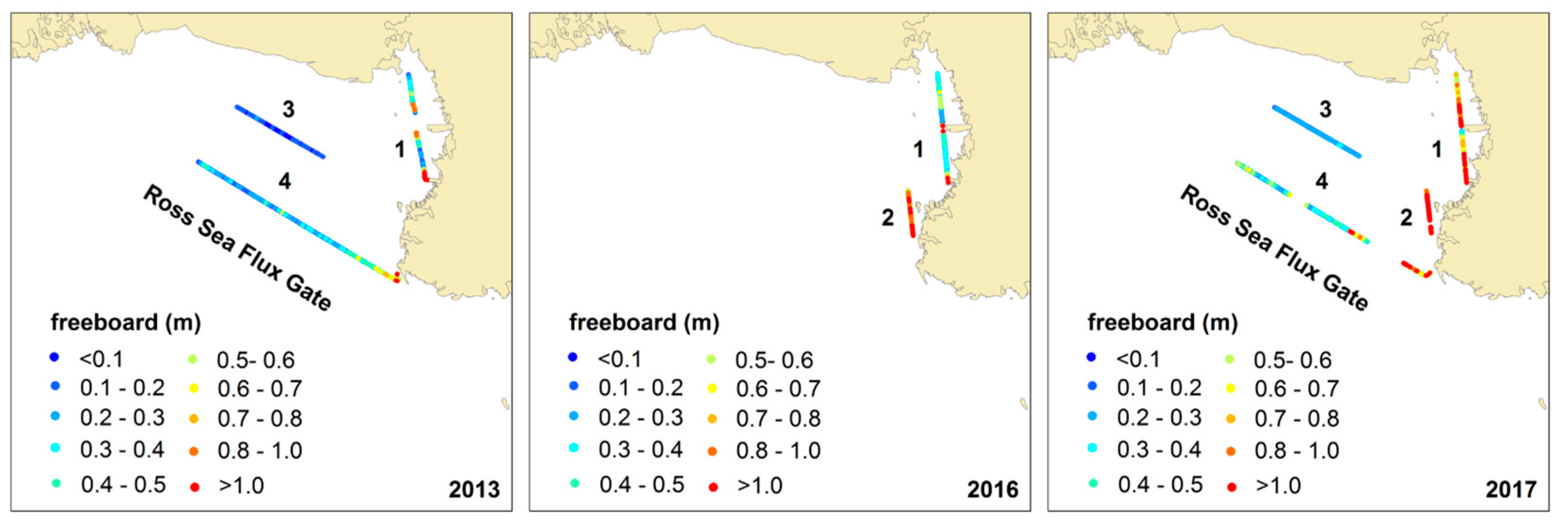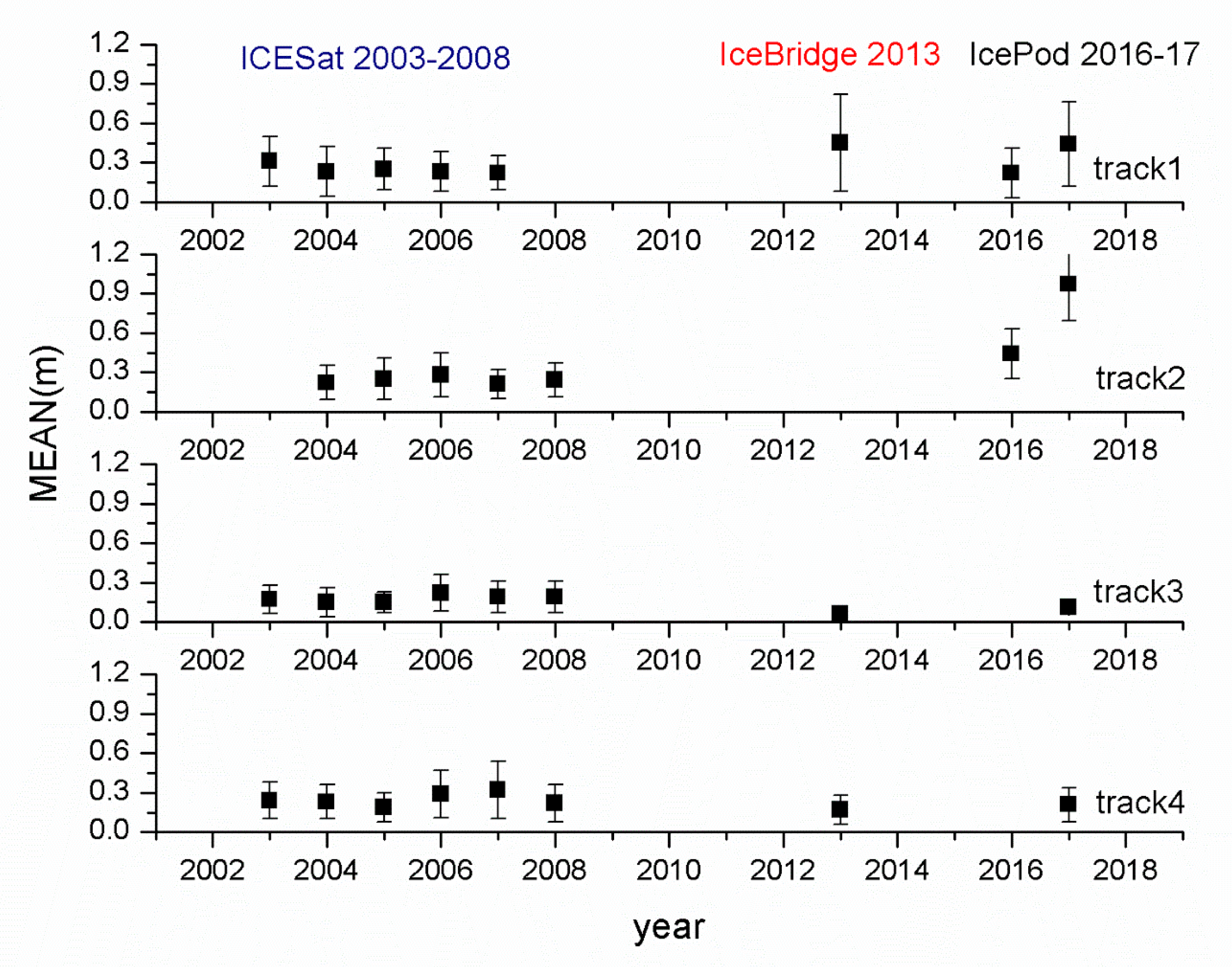Sea Ice Freeboard in the Ross Sea from Airborne Altimetry IcePod 2016–2017 and a Comparison with IceBridge 2013 and ICESat 2003–2008
Abstract
1. Introduction
2. Study Area and Datasets
3. Methods
3.1. Preprocessing of OIB and IcePod Dataset
3.2. Obtain Total Freeboard
4. Results
5. Discussion
6. Conclusions
Author Contributions
Funding
Acknowledgments
Conflicts of Interest
References
- Rinke, A.; Maslowski, W.; Dethloff, K.; Clement, J. Influence of sea ice on the atmosphere: A study with an Arctic atmospheric regional climate model. J. Geophys. Res. Space Phys. 2006, 111, 111. [Google Scholar] [CrossRef]
- Dieckmann, G.S.; Hellmer, H.H. The Importance of Sea Ice: An Overview. Sea Ice 2010, 2, 1–22. [Google Scholar] [CrossRef]
- Parkinson, C.; Cavalieri, D. Antarctic sea ice variability and trends, 1979–2010. The Cryosphere 2012, 6, 871–880. [Google Scholar] [CrossRef]
- Parkinson, C.L. A 40-y record reveals gradual Antarctic sea ice increases followed by decreases at rates far exceeding the rates seen in the Arctic. Proc. Natl. Acad. Sci. USA 2019, 116, 14414–14423. [Google Scholar] [CrossRef]
- Turner, J.; Phillips, T.; Marshall, G.J.; Hosking, J.S.; Pope, J.O.; Bracegirdle, T.J.; Deb, P. Unprecedented springtime retreat of Antarctic sea ice in 2016. Geophys. Res. Lett. 2017, 44, 6868–6875. [Google Scholar] [CrossRef]
- Kusahara, K.; Reid, P.; Williams, G.D.; Massom, R.A.; Hasumi, H. An ocean-sea ice model study of the unprecedented Antarctic sea ice minimum in 2016. Environ. Res. Lett. 2018, 13, 084020. [Google Scholar] [CrossRef]
- Stuecker, M.F.; Bitz, C.M.; Armour, K.C. Conditions leading to the unprecedented low Antarctic sea ice extent during the 2016 austral spring season. Geophys. Res. Lett. 2017, 44, 9008–9019. [Google Scholar] [CrossRef]
- Gordon, A.L.; Comiso, J.C. Polynyas in the Southern Ocean. Sci. Am. 1988, 258, 90–97. [Google Scholar] [CrossRef]
- Maksym, T.; Stammerjohn, S.; Ackley, S.; Massom, R.A. Antarctic Sea Ice—A Polar Opposite? Oceanography 2012, 25, 140–151. [Google Scholar] [CrossRef]
- Lange, M.A.; Eicken, H. The sea ice thickness distribution in the northwestern Weddell Sea. J. Geophys. Res. Space Phys. 1991, 96, 4821. [Google Scholar] [CrossRef]
- Haas, C.; Gerland, S.; Eicken, H.; Miller, H. Comparison of sea-ice thickness measurements under summer and winter conditions in the Arctic using a small electromagnetic induction device. Geophysics 1997, 62, 749–757. [Google Scholar] [CrossRef]
- Yi, D.; Zwally, H.J.; Robbins, J.W. ICESat observations of seasonal and interannual variations of sea-ice freeboard and estimated thickness in the Weddell Sea, Antarctica (2003–2009). Ann. Glaciol. 2011, 52, 43–51. [Google Scholar] [CrossRef]
- Laxon, S.W.; Giles, K.A.; Ridout, A.L.; Wingham, D.J.; Willatt, R.; Cullen, R.; Kwok, R.; Schweiger, A.; Zhang, J.; Haas, C.; et al. CryoSat-2 estimates of Arctic sea ice thickness and volume. Geophys. Res. Lett. 2013, 40, 732–737. [Google Scholar] [CrossRef]
- Xie, H.; Tekeli, A.E.; Ackley, S.F.; Yi, D.; Zwally, H.J. Sea ice thickness estimations from ICESat Altimetry over the Bellingshausen and Amundsen Seas, 2003-2009. J. Geophys. Res. Oceans 2013, 118, 2438–2453. [Google Scholar] [CrossRef]
- Li, H.; Xie, H.; Kern, S.; Wan, W.; Ozsoy, B.; Ackley, S.; Hong, Y. Spatio-temporal variability of Antarctic sea-ice thickness and volume obtained from ICESat data using an innovative algorithm. Remote Sens. Environ. 2018, 219, 44–61. [Google Scholar] [CrossRef]
- Kwok, R.; Cunningham, G.F.; Manizade, S.; Krabill, W. Arctic sea ice freeboard from IceBridge acquisitions in 2009: Estimates and comparisons with ICESat. J. Geophys. Res. Space Phys. 2012, 117, 117. [Google Scholar] [CrossRef]
- Kwok, R.; Cunningham, G.F.; Zwally, H.J.; Yi, D. Ice, Cloud, and land Elevation Satellite (ICESat) over Arctic sea ice: Retrieval of freeboard. J. Geophys. Res. Space Phys. 2007, 112, 112. [Google Scholar] [CrossRef]
- Xie, H.; Ackley, S.; Yi, D.; Zwally, H.; Wagner, P.; Weissling, B.; Lewis, M.; Ye, K. Sea-ice thickness distribution of the Bellingshausen Sea from surface measurements and ICESat altimetry. Deep. Sea Res. Part II Top. Stud. Oceanogr. 2011, 58, 1039–1051. [Google Scholar] [CrossRef]
- Studinger, M. IceBridge ATM L2 Icessn Elevation, Slope, and Roughness, Version 2; NASA Distrib. Active Archive Center, Nat. Snow Ice Data Center: Boulder, CO, USA, 2016. [Google Scholar]
- Ackley, S.F.; Stammerjohn, S.; Maksym, T.; Smith, M.; Cassano, J.; Guest, P.; Tison, J.-L.; Delille, B.; Loose, B.; Sedwick, P.; et al. Sea-ice production and air/ice/ocean/biogeochemistry interactions in the Ross Sea during the PIPERS 2017 autumn field campaign. Ann. Glaciol. 2020, 1–15. [Google Scholar] [CrossRef]
- Bell, R.; Frearson, N.; Zappa, C.; Tinto, K.; Das, I.; Dhakal, T.; Bertinato, C.; Dong, L.; Brown, S.; Le Bel, D. IcePod: Imaging Ice-Ocean Process from Top to Bottom. In Proceedings of the AGU Fall Meeting Abstracts, San Francisco, CA, USA, 15 December 2014. [Google Scholar]
- Tian, L.; Xie, H.; Ackley, S.F.; Tang, J.; Mestas-Nuñez, A.M.; Wang, X. Sea-ice freeboard and thickness in the Ross Sea from airborne (IceBridge 2013) and satellite (ICESat 2003–2008) observations. Ann. Glaciol. 2020, 1–16. [Google Scholar] [CrossRef]
- Dinniman, M.S.; Klinck, J.M.; Smith, W.O., Jr. Cross-shelf exchange in a model of the Ross Sea circulation and biogeochemistry. Deep. Sea Res. Part II Top. Stud. Oceanogr. 2003, 50, 3103–3120. [Google Scholar] [CrossRef]
- Boghosian, A.L.; Pratt, M.J.; Becker, M.K.; Cordero, S.I.; Dhakal, T.; Kingslake, J.; Locke, C.D.; Tinto, K.J.; Bell, R.E. Inside the ice shelf: Using augmented reality to visualise 3D lidar and radar data of Antarctica. Photogramm. Rec. 2019, 34, 346–364. [Google Scholar] [CrossRef]
- Krabill, W. IceBridge ATM L1B Elevation and Return Strength, Version 2; NASA DAAC at the National Snow and Ice Data Center: Boulder, CO, USA, 2013. [Google Scholar]
- Zwally, H.; Schütz, B.; Abdalati, W.; Abshire, J.; Bentley, C.; Brenner, A.; Bufton, J.; Dezio, J.; Hancock, D.; Harding, D.; et al. ICESat’s laser measurements of polar ice, atmosphere, ocean, and land. J. Geodyn. 2002, 34, 405–445. [Google Scholar] [CrossRef]
- Kwok, R.; Zwally, H.J.; Yi, D. ICESat observations of Arctic sea ice: A first look. Geophys. Res. Lett. 2004, 31, 31. [Google Scholar] [CrossRef]
- Kern, S.; Spreen, G. Uncertainties in Antarctic sea-ice thickness retrieval from ICESat. Ann. Glaciol. 2015, 56, 107–119. [Google Scholar] [CrossRef]
- Stewart, R.H. Introduction to Physical Oceanography; Dep. of Oceanogr., Tex. A&M Univ.: College Station, TX, USA, 2008. [Google Scholar]
- Andersen, O.; Knudsen, P.; Stenseng, L. The DTU13 MSS (Mean Sea Surface) and MDT (Mean Dynamic Topography) from 20 years of satellite altimetry. In Proceeding of the International Association of Geodesy Symposia, Heidelberg, Germany, 13 August 2015. [Google Scholar]
- Zwally, H.J.; Yi, D.; Kwok, R.; Zhao, Y.; Kwok, R. ICESat measurements of sea ice freeboard and estimates of sea ice thickness in the Weddell Sea. J. Geophys. Res. Space Phys. 2008, 113, 113. [Google Scholar] [CrossRef]
- Nayak, M.R.; Emery, W.J.; Thomson, R.E.; Voulgaris, G. Data Analysis Methods in Physical Oceanography. Estuaries 1999, 22, 728–730. [Google Scholar] [CrossRef]
- Kwok, R.; Pang, S.S.; Kacimi, S.; Kwok, R. Sea ice drift in the Southern Ocean: Regional patterns, variability, and trends. Elem. Sci. Anth. 2017, 5, 32. [Google Scholar] [CrossRef]
- Kwok, R. Ross Sea Ice Motion, Area Flux, and Deformation. J. Clim. 2005, 18, 3759–3776. [Google Scholar] [CrossRef]
- Martin, S.; Drucker, R.S.; Kwok, R. The areas and ice production of the western and central Ross Sea polynyas, 1992–2002, and their relation to the B-15 and C-19 iceberg events of 2000 and 2002. J. Mar. Syst. 2007, 68, 201–214. [Google Scholar] [CrossRef]
- Comiso, J.C.; Kwok, R.; Martin, S.; Gordon, A.L. Variability and trends in sea ice extent and ice production in the Ross Sea. J. Geophys. Res. Space Phys. 2011, 116, 116. [Google Scholar] [CrossRef]
- Drucker, R.; Martin, S.; Kwok, R. Sea ice production and export from coastal polynyas in the Weddell and Ross Seas. Geophys. Res. Lett. 2011, 38, 38. [Google Scholar] [CrossRef]
- Dai, L.; Xie, H.; Ackley, S.F.; Mestas-Nuñez, A.M. Ice Production in Ross Ice Shelf Polynyas during 2017–2018 from Sentinel–1 SAR Images. Remote Sens. 2020, 12, 1484. [Google Scholar] [CrossRef]
- Urban, T.; Schutz, B.E. ICESat sea level comparisons. Geophys. Res. Lett. 2005, 32, 32. [Google Scholar] [CrossRef]
- Martin, C.F.; Krabill, W.B.; Manizade, S.S.; Russell, R.L.; Sonntag, J.G.; Swift, R.N.; Yungel, J.K. Airborne Topographic Mapper Calibration Procedures and Accuracy Assessment; NASA Tech. Memo. TM–2012-21; National Aeronautics and Space Administration, Goddard Space Flight Center: Greenbelt, MD, USA, 2012. [Google Scholar]
- Geiger, C.A.; Mueller, H.-R.; Samluk, J.P.; Bernstein, E.R.; Richter-Menge, J. Impact of spatial aliasing on sea-ice thickness measurements. Ann. Glaciol. 2015, 56, 353–362. [Google Scholar] [CrossRef]
- Kwok, R.; Kacimi, S.; Markus, T.; Kurtz, N.T.; Studinger, M.; Sonntag, J.G.; Manizade, S.S.; Boisvert, L.N.; Harbeck, J.P. ICESat-2 Surface Height and Sea Ice Freeboard Assessed With ATM Lidar Acquisitions From Operation IceBridge. Geophys. Res. Lett. 2019, 46, 11228–11236. [Google Scholar] [CrossRef]
- Pachauri, R.K.; Reisinger, A. IPCC Fourth Assessment Report; IPCC: Geneva, Switzerland, 2007. [Google Scholar]
- Shakun, J.D.; Clark, P.U.; He, F.; Marcott, S.A.; Mix, A.C.; Liu, Z.; Otto-Bliesner, B.; Schmittner, A.; Bard, E. Global warming preceded by increasing carbon dioxide concentrations during the last deglaciation. Nature 2012, 484, 49–54. [Google Scholar] [CrossRef] [PubMed]






| Dataset | Acquisition Time | Tracks |
|---|---|---|
| ICESat | 2003, 09/25–11/18 | 1,3,4 |
| ICESat | 2004, 10/03–11/08 | 1,2,3,4 |
| ICESat | 2005, 10/21–11/23 | 1,2,3,4 |
| ICESat | 2006, 10/25–11/27 | 1,2,3,4 |
| ICESat | 2007, 10/02–11/04 | 1,2,3,4 |
| ICESat | 2008, 10/04–10/18 | 2,3,4 |
| OIB | 2013, 11/20 and 11/27 | 1,3,4 |
| IcePod | 2016, 11/27 and 11/28 | 1,2, |
| IcePod | 2017, 11/21 and 11/22 | 1,2,3,4 |
| Tracks | Mean Freeboard (m) | Mean Difference (m) | |
|---|---|---|---|
| (2003–2008) | (2013–2017) | ||
| ICESat (a) | OIB/IcePod (b) | (b − a) ± 1 SD | |
| track 1 | 0.258 (2003–2007) | 0.331 (2013, 2016 and 2017) | 0.073 ± 0.003 |
| track 2 | 0.235 (2004–2008) | 0.668 (2016 and 2017) | 0.433 ± 0.006 |
| track 3 | 0.182 (2003–2008) | 0.100 (2013 and 2017) | −0.081 ± 0.002 |
| track 4 | 0.251 (2003–2008) | 0.189 (2013 and 2017) | −0.062 ± 0.002 |
© 2020 by the authors. Licensee MDPI, Basel, Switzerland. This article is an open access article distributed under the terms and conditions of the Creative Commons Attribution (CC BY) license (http://creativecommons.org/licenses/by/4.0/).
Share and Cite
Tian, L.; Xie, H.; Ackley, S.F.; Tinto, K.J.; Bell, R.E.; Zappa, C.J.; Gao, Y.; Mestas-Nuñez, A.M. Sea Ice Freeboard in the Ross Sea from Airborne Altimetry IcePod 2016–2017 and a Comparison with IceBridge 2013 and ICESat 2003–2008. Remote Sens. 2020, 12, 2226. https://doi.org/10.3390/rs12142226
Tian L, Xie H, Ackley SF, Tinto KJ, Bell RE, Zappa CJ, Gao Y, Mestas-Nuñez AM. Sea Ice Freeboard in the Ross Sea from Airborne Altimetry IcePod 2016–2017 and a Comparison with IceBridge 2013 and ICESat 2003–2008. Remote Sensing. 2020; 12(14):2226. https://doi.org/10.3390/rs12142226
Chicago/Turabian StyleTian, Liuxi, Hongjie Xie, Stephen F. Ackley, Kirsty J. Tinto, Robin E. Bell, Christopher J. Zappa, Yongli Gao, and Alberto M. Mestas-Nuñez. 2020. "Sea Ice Freeboard in the Ross Sea from Airborne Altimetry IcePod 2016–2017 and a Comparison with IceBridge 2013 and ICESat 2003–2008" Remote Sensing 12, no. 14: 2226. https://doi.org/10.3390/rs12142226
APA StyleTian, L., Xie, H., Ackley, S. F., Tinto, K. J., Bell, R. E., Zappa, C. J., Gao, Y., & Mestas-Nuñez, A. M. (2020). Sea Ice Freeboard in the Ross Sea from Airborne Altimetry IcePod 2016–2017 and a Comparison with IceBridge 2013 and ICESat 2003–2008. Remote Sensing, 12(14), 2226. https://doi.org/10.3390/rs12142226






